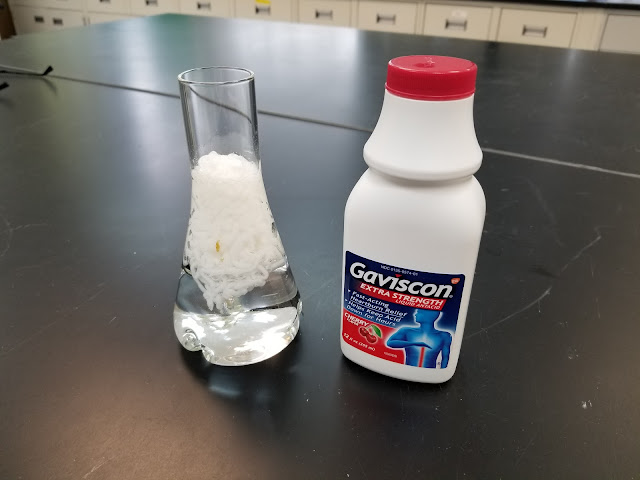One way antacid can work is by reducing the acidity of the acid in your stomach. If the acid is not as strong it will not inflame the esophagus as much. However the antacid Gaviscon works a completely different way and the chemistry is pretty ingenious.
The main ingredients of Gaviscon are:
Sodium alginate
Sodium bicarbonate
Calcium carbonate.
The chemistry behind Gaviscon is pretty neat.
Sodium Alginate is a polymer that is derived from seaweed. Once it goes into the stomach, the acid in our stomach makes it go from a soluble state to an insoluble state. In other words it becomes a solid. Secondly there will be Calcium ions in the stomach from the calcium carbonate. The calcium helps to cross-link the alginate molecules together into something called an "alginate raft." You are left with a big piece of solid material in your stomach from the medicine.
The second piece of the story is the calcium carbonate and sodium bicarbonate react with the acid in your stomach to form carbon dioxide gas. The gas that is formed propels the solid alginate raft upwards. It gets caught at the top of the stomach where the esophagus and stomach come together and forms a barrier. This barrier prevents acid from going up into the esophagus.
This is an amazing piece of chemistry and all of it relies on the acid in our stomach to start the reactions. The neat part is we can replicate the experiment.
Supplies needed:
- 250 ml flask: This replicates your stomach. The bottom portion is your stomach and the neck of the flask is your esophagus.
- 50 mL Gaviscon liquid
- 150 mL of 1M Hydrochloric Acid - This can be pretty nasty and most will not have access to this. So be very careful if you do. (safety glasses, coat, eye protection)
The Experiment
This experiment is quite simple.
1. Add 150 mL of 1M HCl into the flask
2. Add 50 mL of Gaviscon to the flask
3. Observe
Watch the Gaviscon go from a liquid to a solid while the alginate raft forms. Observe Carbon dioxide bubbles forming. And finally watch the gas push the raft up to the neck of the flask and form a barrier.
The barrier actually makes it difficult to get the HCl out of the flask when we cleaned up!!
You just saw a real life application of chemistry in a over the counter medicine thousands of people use everyday. And it was so fun seeing the students doing the experiment.






No comments:
Post a Comment